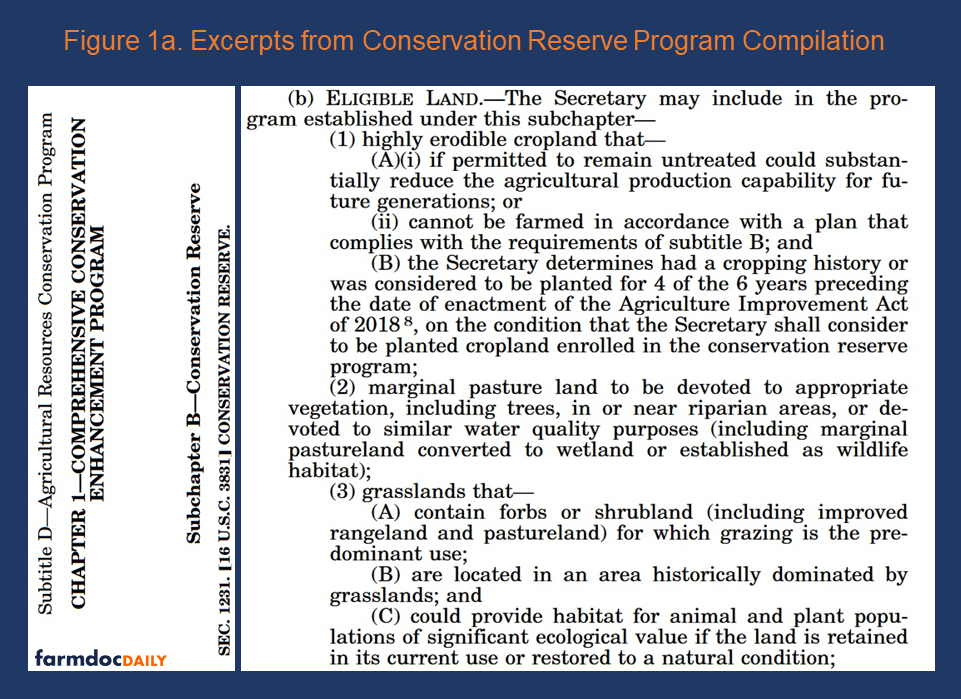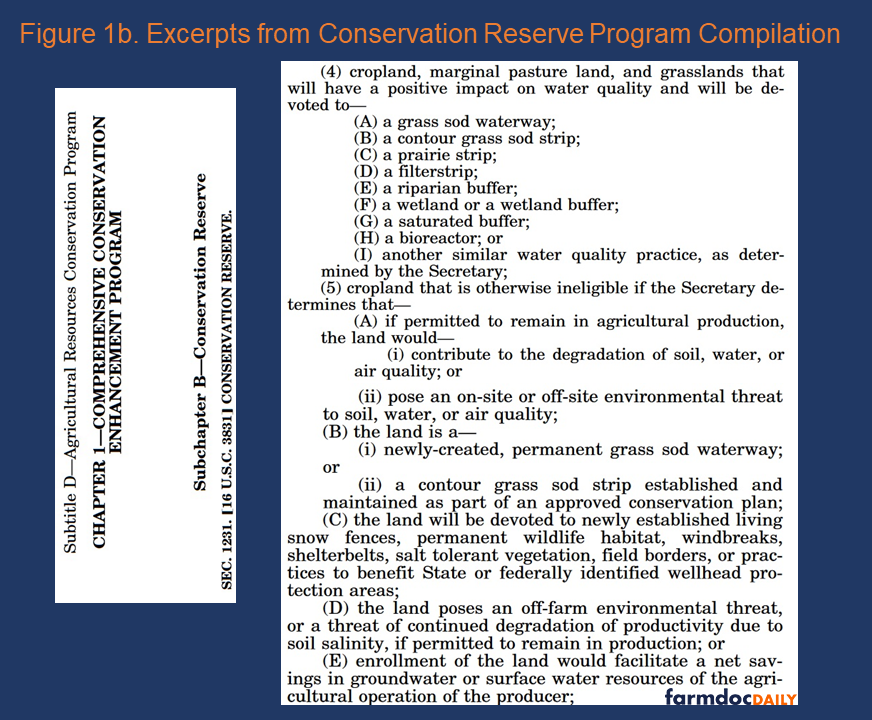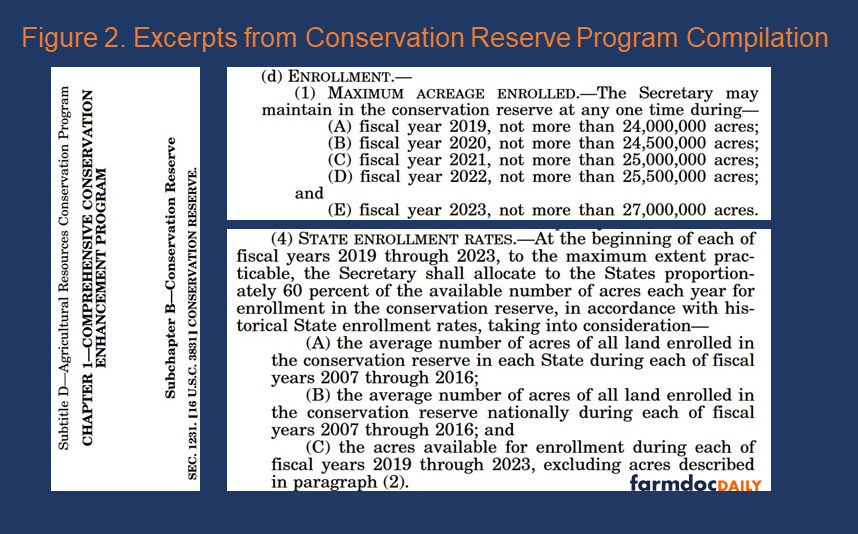A View of the Farm Bill Through Policy Design, Part 6: Conservation Reserve Program
Perched on the precipice of another federal government shutdown, Congress struggles with its most basic functions because of anther political partisan hostage situation precipitated by a small faction inside the House Republican caucus (Bade, September 21, 2023; Tully-McManus and Cancryn, September 20, 2023; Ferris and Beavers, September 20, 2023; Berg, September 20, 2023; Klahr, September 19, 2023; on faction, see e.g.: Hamilton, The Federalist No. 9; Madison, The Federalist No. 10; farmdoc daily, November 11, 2022). Not surprisingly, the potential for reauthorizing a farm bill by September 30th fades quickly in the ruckus; December has become the new deadline (Abbott, September 19, 2023; Douglas, September 19, 2023). Alas, analysis continues unabated; this week’s installment on the farm bill reviews the Conservation Reserve Program and builds upon previous work (farmdoc daily, March 24, 2022; May 4, 2017).
Background
This article continues the series exploring the major mandatory titles, policies, and programs in the Farm Bill, as well as providing updates on development of the Policy Design Lab, a web-based resource in which to explore and analyze policies (see, farmdoc daily, April 13, 2023; May 11, 2023; June 8, 2023; August 24, 2023; September 7, 2023). The goal of the Policy Design Lab is to incorporate and apply research, publicly available data, and computational resources for analysis and visualization of federal agricultural policies, guided by statutory provisions or legislative options to produce comparative analysis. For each of the major mandatory farm bill programs, the starting point is visualizing the status quo with maps and charts of the distribution of benefits and payments by state.
In historical context, it would be difficult to overstate the place of the Conservation Reserve Program (CRP) in American farm policy. The modern CRP was enacted as a key part of the landmark Food Security Act of 1985 (P.L. 99-198). The policy of renting acres out of production because those acres are highly erodible or otherwise of concern from a natural resource perspective dates to the Dust Bowl of the 1930s when Congress enacted the Soil Conservation and Domestic Allotment Act of 1936 (P.L. 74-461). The first version of the conservation reserve, however, was included as part of the Soil Bank in the Agricultural Act of 1956 (P.L. 84-540); proposed by President Dwight Eisenhower, success required his veto of the first version of the farm bill to overcome resistance in Congress (farmdoc daily, January 9, 2020; January 24, 2020; February 20, 2020). Congress permitted the 1956 version of the conservation reserve to expire in 1960. Twin farm crises in the 1980s—an economic crisis and a crisis of soil erosion—provided the catalyst for Congress to recreate the policy in the modern CRP in addition to creating conservation compliance. As political achievement, conservation compliance and CRP earned their monumental status: with farmers struggling in an economic crisis second only to the Great Depression, there was almost no opposition to conditioning farm program payments and crop insurance on compliance with highly erodible lands and wetlands requirements; the persistent budget cutting pressures from the Reagan Administration did not prevent Congress from adding CRP to the Farm Bill with an enrollment cap at 45 million acres, double the current acreage cap.
Discussion
Seemingly self-evident, the Conservation Reserve Program (CRP) is a land-based or acreage-based conservation program. Landowners offer to enroll whole fields or portions of fields. The acres accepted are taken out of production and placed into conserving cover (e.g., grasses and/or trees). The policy is designed around these acres of eligible lands that will be switched from production to conservation. In return, the landowner receives an annual rental payment for those acres placed under conservation. CRP is a land or acreage reserve, compared to a policy like the Environmental Quality Incentives Program (EQIP), which pays a portion of the estimated cost to implement specific conservation practices. Figures 1a and 1b present excerpts from the statutory compilation of CRP from the Senate Committee on Agriculture, Nutrition, and Forestry, highlighting the lands eligible for enrollment (Senate ANF, Compilations: Food Security Act of 1985, Title XII). These excerpts emphasize not just the types of land eligible for enrollment, but also the policy and conservation goals: highly erodible cropland; marginal pasture land; grasslands; such lands upon which conservation will improve water quality; and environmentally sensitive cropland that will contribute to water, soil or air quality degradation if it remains in production or poses some threat to soil, water, and air quality (16 U.S.C. §3831).
The 2018 Farm Bill increased the CRP acreage cap from 24 million acres in fiscal year (FY) 2019 to the current cap of 27 million acres (FY2023) (P.L. 115-334). Figure 2 highlights the acreage enrollment limit as currently authorized, as well as the state enrollment allocations. The acreage enrollment cap also differentiates CRP from EQIP and the Conservation Stewardship Program (CSP) which operate under fixed funding caps. The acreage cap allows USDA to enroll acres that qualify for the program at rental rates at least relatively relevant to local cash rents.
Figure 3 contains the interactive map and additional data visualizations produced by the Policy Design Lab project (https://policydesignlab.ncsa.illinois.edu/crp). Total CRP rental payments or benefits from FY2018 to FY2022 are presented by State. Users can also select among the three sub-programs of CRP: general sign-up, the traditional whole field enrollment; total continuous sign-up, partial field enrollments; and grasslands. The total continuous sub-program has three categories as well: Conservation Reserve Enhancement Program (CREP), which operates through agreements with states or other entities (16 U.S.C. §3831a); continuous non-CREP; and farmable wetlands (16 U.S.C. §3831b). Below the map is further information including the total CRP payments in these fiscal years ($8.95 billion), and that nearly 37% of the payments are for the general enrollment acres, 61% for continuous enrollment, and just over 1% in grasslands. Below the graphic is an interactive table presenting the data for CRP, including number of contracts, farms, and Acres as of September 2022.
Figure 3. Total CRP Benefits from 2018-2022
As discussed previously, CRP has evolved significantly from its original design as a whole-field reserve program as continuous and grasslands enrollments have grown (farmdoc daily, July 10, 2023; February 17, 2022). These changes have important implications, permitting the program to grow and adapt to changing circumstances in the farm economy, as well as adjusting to changing policy priorities and goals. Continuous enrollments, as well as farmable wetlands, allow CRP to operate more as a working lands conservation program because those acres not enrolled remain in production and the CRP acres help preserve soils, water, and other natural resources. Similarly, grasslands enrolled acres permit grazing. In addition, Congress has experimented with different design features through pilot programs (16 U.S.C. §3831c). The pilot programs demonstrate the potential flexibility and fundamental adjustability of the program: one provides for 30-year enrollments; another provides for shorter term enrollments (3, 4, or 5 years) to improve soil health. The basic design—providing annual rental payments in return for adapting conservation practices on the land—allows for this flexibility and adjustability.
The subprogram designs also allow CRP to maintain an important presence throughout the country and within the most productive regions or States. For example, the top two states in terms of total CRP benefits are Iowa ($1.9 billion; 21.7% of the national total) and Illinois ($841 million; 9.4% of the national total) are not the largest in terms of total acres enrolled (Texas, 13 million acres and Kansas, 9 million acres). Clicking through the table, both Iowa and Illinois receive over 80% of their total CRP benefits from continuous enrollments, while Texas receives 86% of its total benefits through general enrollments and Kanas receives 75% of its total benefits from general enrollments.
Concluding Thoughts
Approaching its 40th birthday, the Conservation Reserve Program remains the largest conservation program in Title II of the Farm Bill. The Congressional Budget Office projects over $25 billion in total outlays for CRP in the ten-year (FY 2024-2033) baseline. CRP was first authorized in the landmark Food Security Act of 1985, but the policy was rooted in the acreage policies of the Dust Bowl era and the Soil Bank of 1956. The modern CRP has built upon those traditional conservation policies, evolving and expanding to include partial field enrollments that compliment working lands and protect soil, water, or other natural resources in conjunction with farming. Congress has also experimented with new designs and policy goals through pilot programs.
Reviewing CRP demonstrates further how the words of the statute put policies into action. The design of a program determines the operation of policies and the distribution of benefits. For CRP, acres are at the core of the policy. Congress establishes a fixed level of acres that USDA is permitted to enroll and provides multiple pathways for landowners to offer acres for enrollment. With general sign-up, whole fields that are considered environmentally sensitive or of concern can be placed under conservation for 10 or 15 years. With continuous sign-up, landowners have multiple options to enroll a portion of the acres in a field and combine natural resource conservation with farm production. As the 2023 federal fiscal year closes out, USDA’s Farm Service Agency (FSA), which operates CRP, recently reported a total of 22,987,863 acres on 395,868 farms enrolled in the program (USDA-FSA, CRP Contract Summary and Statistics, July 2023). These are acres that will spend at least 10 years under conservation cover and practices, protecting and rehabilitating the soil as well as waterways and other natural resources—a substantial commitment by American society to conserve that which helps sustain the production from which we nourish ourselves.
References
Abbott, Chuck. “Capitol Hill logjam, funding shortage shift farm bill target to December.” FERN’s Ag Insider, September 19, 2023. https://thefern.org/ag_insider/capitol-hill-logjam-funding-shortage-shift-farm-bill-target-to-december/ and Successful Farming, September 20, 2023. https://www.agriculture.com/capitol-hill-logjam-funding-shortage-shift-farm-bill-target-to-december-7972078.
Bade, Rachel. “Major doubts cloud the House GOP’s supposed ‘breakthrough.’” Politico.com, September 21, 2023. https://www.politico.com/news/2023/09/21/house-republicans-mccarthy-spending-deal-shutdown-00117324.
Berg, Matt. “’Weak,’ ‘Lying like a dead dog’: McCarthy faces Republican attacks amid looming shutdown.” Politico.com, September 20, 2023. https://www.politico.com/news/2023/09/20/mccarthy-government-shutdown-gaetz-00117027
Coppess, J. "Considering Congress, Part 2: The Mortal Disease of Self-Government." farmdoc daily (12):170, Department of Agricultural and Consumer Economics, University of Illinois at Urbana-Champaign, November 11, 2022.
Coppess, J. and C. Laingen. "Mapping the Farm Bill: Reviewing the CRP; Law, Land & History." farmdoc daily (12):39, Department of Agricultural and Consumer Economics, University of Illinois at Urbana-Champaign, March 24, 2022.
Coppess, J. "Historical Background on the Conservation Reserve Program." farmdoc daily (7):82, Department of Agricultural and Consumer Economics, University of Illinois at Urbana-Champaign, May 4, 2017.
Coppess, J. "A View of the Farm Bill Through Policy Design, Part 3: SNAP." farmdoc daily (13):105, Department of Agricultural and Consumer Economics, University of Illinois at Urbana-Champaign, June 8, 2023.
Coppess, J. "A View of the Farm Bill Through Policy Design, Part 4: ARC and PLC." farmdoc daily (13):156, Department of Agricultural and Consumer Economics, University of Illinois at Urbana-Champaign, August 24, 2023.
Coppess, J. "A View of the Farm Bill Through Policy Design, Part 5: Crop Insurance." farmdoc daily (13):162, Department of Agricultural and Consumer Economics, University of Illinois at Urbana-Champaign, September 7, 2023.
Coppess, J. "The Conservation Question, Part 5: Seeds of the Soil Bank." farmdoc daily (10):3, Department of Agricultural and Consumer Economics, University of Illinois at Urbana-Champaign, January 9, 2020.
Coppess, J. "The Conservation Question, Part 6: Development of the Soil Bank." farmdoc daily (10):13, Department of Agricultural and Consumer Economics, University of Illinois at Urbana-Champaign, January 24, 2020.
Coppess, J. "The Conservation Question, Part 7: Losing the Soil Bank." farmdoc daily (10):31, Department of Agricultural and Consumer Economics, University of Illinois at Urbana-Champaign, February 20, 2020.
Coppess, J. and A. Knepp. "A View of the Farm Bill Through Policy Design, Part 2: CSP." farmdoc daily (13):86, Department of Agricultural and Consumer Economics, University of Illinois at Urbana-Champaign, May 11, 2023.
Coppess, J. and A. Knepp. "A View of the Farm Bill Through Policy Design, Part 1: EQIP." farmdoc daily (13):69, Department of Agricultural and Consumer Economics, University of Illinois at Urbana-Champaign, April 13, 2023.
Douglas, Leah. “Expect farm bill in December, says chair of Senate farm committee.” Reuters.com. September 19, 2023. https://www.reuters.com/world/us/expect-farm-bill-december-says-chair-senate-farm-committee-2023-09-19/.
Ferris, Sarah and Olivia Beavers. “McCarthy’s biggest conservative critics have something important in common.” Politico.com, September 20, 2023. https://www.politico.com/live-updates/2023/09/20/congress/the-rebels-common-trait-00117046.
Hamilton, Alexander. “The Utility of the Union as a Safeguard Against Domestic Faction and Insurrection.” The Federalist Papers No. 9, Library of Congress. https://guides.loc.gov/federalist-papers/text-1-10#s-lg-box-wrapper-25493273.
Klahr, Renee. “’Clown show’: House GOP fights over continuing resolution.” Politico.com, September 19, 2023. https://www.politico.com/video/2023/09/19/clown-show-house-gop-fights-over-continuing-resolution-1056822.
Madison, James. “The Same Subject Continued: The Union as a Safeguard Against Domestic Faction and Insurrection.” The Federalist Papers No. 10, Library of Congress. https://guides.loc.gov/federalist-papers/text-1-10#s-lg-box-wrapper-25493273.
Tully-McManus, Katherine and Adam Cancryn. “Republicans resigned to being the villians in the inevitable government shutdown.” Politico.com. September 20, 2023. https://www.politico.com/news/2023/09/20/republicans-villains-government-shutdown-00117191
Zulauf, C. "Is It Time to Repurpose CRP?" farmdoc daily (13):126, Department of Agricultural and Consumer Economics, University of Illinois at Urbana-Champaign, July 10, 2023.
Zulauf, C., N. Paulson, K. Swanson and G. Schnitkey. "Conservation Reserve Program’s Evolving Mission." farmdoc daily (12):22, Department of Agricultural and Consumer Economics, University of Illinois at Urbana-Champaign, February 17, 2022.
Disclaimer: We request all readers, electronic media and others follow our citation guidelines when re-posting articles from farmdoc daily. Guidelines are available here. The farmdoc daily website falls under University of Illinois copyright and intellectual property rights. For a detailed statement, please see the University of Illinois Copyright Information and Policies here.










